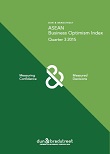Assessing Foreign Investment Potential in Vietnam Through the Business Optimism Index
Over the past several years, Vietnam has shown itself to be a rising powerhouse in ASEAN, and foreign investment into the country has reflected this growth. In the last six years, Vietnam has sustained FDI levels of around US$10-12 billion per year. The latest Business Optimism Index by Dun & Bradstreet seeks to measure this rapid ascension of Vietnam and other ASEAN countries as measured through sales volume, net profit, selling price, new orders, inventory, and employment across sectors and industries. In this article, we highlight key findings for Vietnam in the Index and their implications for foreign investors.
Business Optimism for Foreign Investment in Vietnam
While Vietnam only accounted for six percent of ASEAN’s total GDP in 2014, business confidence in the country improved by 16 percentage points from Q2 to Q3, topping all ASEAN countries highlighted in the Index. Five of the six optimism parameters above rose for Vietnam in Q3, and nearly half of all respondents (46 percent) anticipated better business conditions in the coming quarter.
Optimism in both sales volume and net profit in Vietnam rose almost 30 percent from Q2, a second consecutive quarter-on-quarter growth for both parameters. The manufacturing and construction sectors posted the highest scores for optimism of all industries, at 88 percent and 84 percent respectively. The optimism of these sectors reflects the substantial growth and influx of foreign investment seen by Vietnam over the past few quarters; a trend also seen overall during the past several years.
 RELATED: Dezan Shira & Associates’ Pre-Investment, Market Entry Strategy Advisory
RELATED: Dezan Shira & Associates’ Pre-Investment, Market Entry Strategy Advisory
New orders in Vietnam also saw a significant increase from last quarter. Almost two-thirds of respondents (64 percent) expect that new orders will increase in Q3, while only two percent anticipate a decrease.
In order to cope with these new orders and rising sales, optimism in employment has accordingly risen – a fifteen percent quarter-on-quarter increase. The recent heating up of the Vietnamese real estate market in recent quarters has also led to this rise in optimism for employment. The construction sector saw a nearly 45 percent increase here from Q2 to Q3.
All other sectors have maintained moderate levels for employment at around 20-25 percent. Manufacturing is the only sector to have posted a quarter-on-quarter decrease in employment, most likely due to the fact that the sector is reaching a stable phase after quarters of explosive growth.
Implications for Foreign Investors
As China’s rapid growth over the past decade slows, foreign companies investing in the country are increasingly looking to expand and diversify their operations and assets. Vietnam has become one of the top sources for this diversification in recent years, and, based on the Index, foreign companies are expected to continue this upward trend in investment in the coming quarter.
This rising business optimism, combined with the growing export momentum in Vietnam caused by the imminent onset of the Trans-Pacific Partnership, are promising factors indicative of Vietnam’s continued and steady rise in ASEAN as a destination for foreign investment.
 The Business Optimism Index, released every quarter by Dun & Bradstreet, is considered a leading economic indicator for turning points in business activity and measuring business sentiment. The Index captures business expectations for the quarter ahead based on six parameters: sales volume, net profit, selling price, new orders, inventory, and employment. Sampling in the Index represents key business sectors including manufacturing, construction, wholesale, transportation, services, finance, mining and agriculture, according to their GDP contribution in each nation. The Business Optimism Index, released every quarter by Dun & Bradstreet, is considered a leading economic indicator for turning points in business activity and measuring business sentiment. The Index captures business expectations for the quarter ahead based on six parameters: sales volume, net profit, selling price, new orders, inventory, and employment. Sampling in the Index represents key business sectors including manufacturing, construction, wholesale, transportation, services, finance, mining and agriculture, according to their GDP contribution in each nation.
The ASEAN Business Optimism Index for Q3 2015 is out now and available as a complimentary download in the Asia Briefing Bookstore. |
Import and Export: A Guide to Trade in Vietnam
In this issue of Vietnam Briefing Magazine, we provide you with a clear understanding of the current business trends related to trade in Vietnam, as well as explaining how to set up your trading business in the country. We also attempt to give perspective on what will be Vietnam’s place in the Association of Southeast Asian Nations (ASEAN) in 2015, and look at some of the country’s key import and export regulations.
 Using Vietnam’s Free Trade & Double Tax Agreements
Using Vietnam’s Free Trade & Double Tax Agreements
In this issue of Vietnam Briefing we explore how Vietnam’s Free Trade Agreements – and especially those via its membership in ASEAN – will affect foreign investment into Vietnam. We also go a step further and examine the specific, bilateral Double Tax Agreements that Vietnam has enacted, and how these can be further used to minimize profits and withholding taxes that would otherwise be levied upon foreign investors.
 Developing Your Sourcing Strategy for Vietnam
Developing Your Sourcing Strategy for Vietnam
In this issue of Vietnam Briefing Magazine, we outline the various sourcing models available for foreign investors – representative offices, service companies and trading companies – and discuss how to decide which structure best suits the sourcing needs of your business.
- Previous Article Vietnam Tops Global Greenfield FDI Project Rankings
- Next Article Ford Sees Long-Term Opportunity in Vietnam’s Auto Industry

































